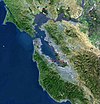Save the Bay
This article has multiple issues. Please help improve it or discuss these issues on the talk page. (Learn how and when to remove these messages)
|
| Founded | 1961[1][2] |
|---|---|
| Founder | Kay Kerr, Sylvia McLaughlin and Esther Gulick[1][2] |
| Type | Non-profit 501(c)3 |
| Focus | Open space preservation, Natural habitat restoration, Environmental justice |
| Location | |
Area served | San Francisco Bay Area |
Members | 25,000[2] |
Key people | Executive Director David Lewis[3] |
| Website | www.savesfbay.org |
Formerly called | Save San Francisco Bay Association |
Save The Bay is a nonprofit organization dedicated to preserving San Francisco Bay and its related estuarine habitat areas. Founded by Catherine Kerr, Sylvia McLaughlin, and Esther Gulick in 1961, the organization grew into a body that not only achieved its namesake but also inspired analogous organizations dedicated to other environmental and other political causes. The organization continues to fight to protect the bay from development and landfill and to oppose redevelopment of salt flats; it instead encourages their restoration to a natural state.

History
The organization helped to spark the environmental movement in the United States. The women were successful in saving the bay. They lobbied the state government until state legislation in 1965 established the San Francisco Bay Conservation and Development Commission as a state agency. The commission drew up a master plan for San Francisco Bay, which provided for orderly development as well as preservation. It was the first such agency in California and later inspired the creation of the California Coastal Commission. In 1961 Sylvia McLaughlin and 2 other women Kay Kerr, Esther Gulick. They worked together and decided to send 1,000 letters asking for $1 membership. In just a few days the 900 responses came in and it was $900.
Today
The organization still works to protect the wildlife of the Bay Area and water quality of the uniquely large inland body of water.[1][4] When it was founded it was the first successful regional grassroots campaign to achieve that sort of goal.[1] Save The Bay prevented the destruction of San Bruno Mountain to fill 27 miles (44 km) of the San Mateo County shoreline.[1] The founders' main goal was to preserve the natural beauty of the bay.[1] Their efforts have also been noted as the first successful conservation efforts in an urban area.[1]
The women's efforts led to the creation of the Bay Conservation and Development Commission, which was later used as the blueprint and inspiration for other government commissions such as the Tahoe Regional Planning Agency, California Coastal Commission, and Delta Stewardship Council.[1]
To this day, Save The Bay impacts are restoring wetlands, stopping pollution, restoring funding, preventing bay filling and Bay Smart victory.
Restoring wetlands: Save The Bay has embarked on a series of the groundwork for restoring wetlands and wildlife habitat, starting with community-based restoration with a focus on restoring transitional habitat near salt marshes in areas above the mean high-water line. Save The Bay has been focusing on transition habitat restoration in The San Francisco Bay Area since 2000. In addition, since The Website of Save The Bay is easy for the public to access, it makes it easier for Save The Bay to participate in the restoration plan. Each year, more than 5,000 adults and students volunteer to restore habitat specifically to the transition zone.
Stop the Pollution: Save The Bay has been a leader in reducing plastic pollution in The Bay and has worked with other regional, regional and state-wide organizations to advocate for local bans on plastic bags, Styrofoam and outdoor smoking to reduce the amount of toxic waste flowing into The Bay. And over the past 10 years, Save The Bay has succeeded in getting more than 80 cities to adopt local baggage bans and nearly 50 cities to ban Styrofoam takeout containers by advocating and recommending dozens of bans on these products.
Restoration funding: Save The Bay has led the way in creating hundreds of millions of dollars in public funding through ballot measures and legislation to protect The people and wildlife of San Francisco Bay.
Preventing Bay filling: Save The Bay, which was founded to stop Bay filling, has accomplished its original mission, and ensured that most Bay landfills are prohibited by law.
Bay Smart Victory: Save The Bay by supporting policies to reduce urban runoff pollution, improve public transportation, and protect and build affordable housing. These policies have protected the Bay and improved the quality of life in the region, providing clean water, sustainable transport, affordable housing, and climate resilience.
Plastic bag bans
The organization has also embraced and pushed for plastic bag bans throughout the entire region. It includes strong support for strengthening the San Francisco plastic bag ban in 2011 that banned all retailers from giving out bags made of non-biodegradable materials.[5] Save The Bay supported the 2012 San Jose, California, ban on plastic bags.[6]
See also
References
- ^ a b c d e f g h Taugher, Mike (2011-11-05). "A pioneer remembers how she and friends saved the bay". Contra Costa Times. Archived from the original on 2012-01-16. Retrieved 2012-01-10.
- ^ a b c "Our History". Save The Bay. 2012. Archived from the original on 2012-01-16. Retrieved 2012-01-16.
- ^ Lewis, David; Russ Juskalian (2012). "Message from the Executive Director". Save The Bay. Archived from the original on 2012-01-16. Retrieved 2012-01-16.
- ^ Sylvia McLaughlin, Save the Bay founder, fights on, Peter Fimrite, San Francisco Chronicle, 31-10-2011, access date 10-01-2012
- ^ Let's make all S.F. retailers comply with bag ban, David Lewis, San Francisco Chronicle, 05-12-2011, access date 10-01-2012
- ^ Attention, shoppers: Get ready to BYOB (bring your own bag) in San Jose stores, Tracy Seipel, San Jose Mercury News, 25-12-2011, access date 08-01-2012
Further reading
- Gilliam, Harold (1969). Between the devil & the deep blue bay: the struggle to save San Francisco Bay. Chronicle Books.

